Make the most of your precuts! Warm Jelly Roll Quilt Tutorial
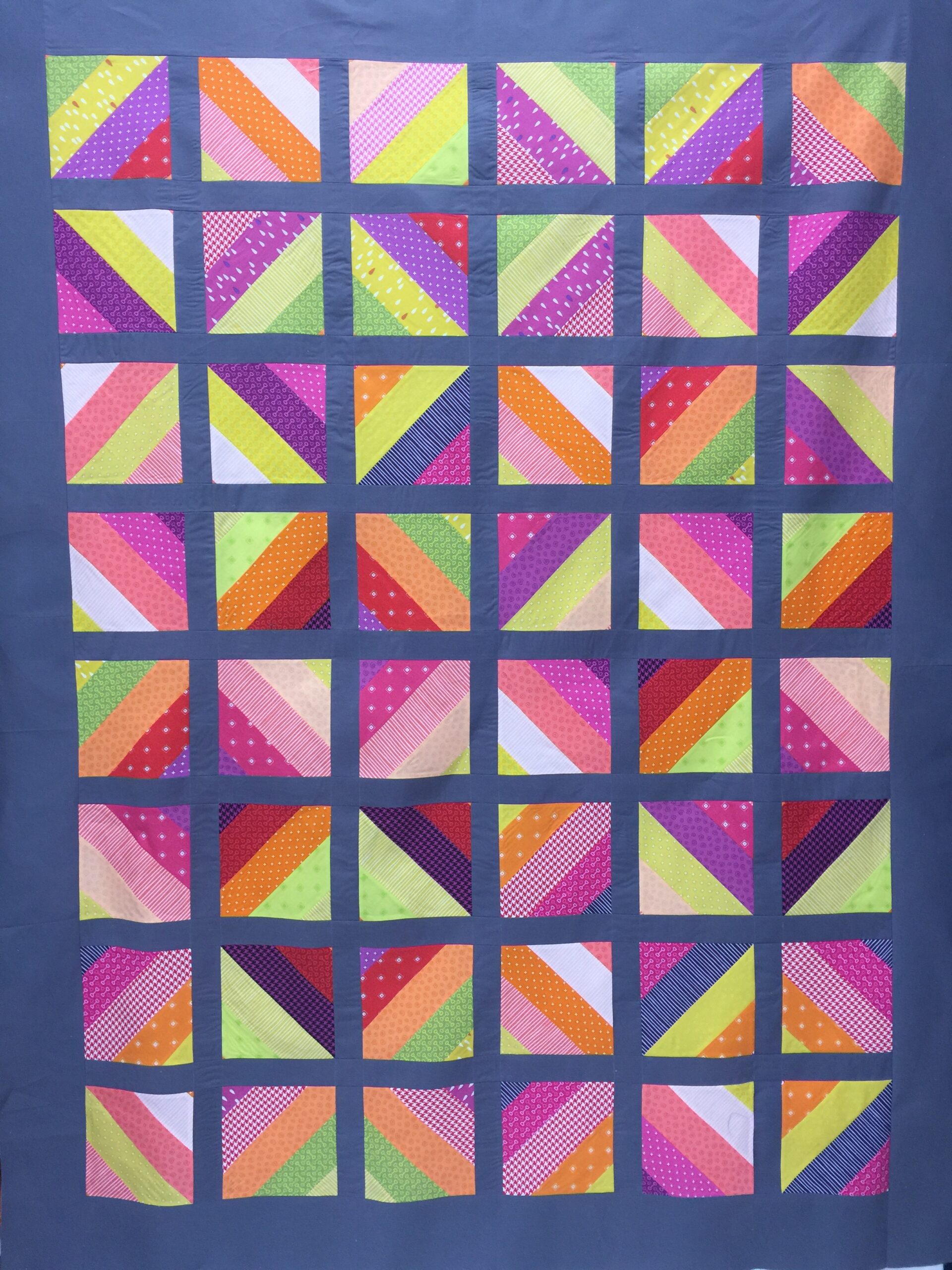
Do you find yourself collecting precuts with no real plan for what you’ll do with them once you get them home? It’s easy to be drawn to the coordinating fabrics stacked so prettily together, with a price tag much less than a fat quarter bundle of the same collection. Today, I’ll show you how to use up a Jelly Roll in a way that will really show case those fabrics you love so much while utilizing the ¼” piecing foot on the Janome Horizon Memory Craft 8900QCP Special Edition. Once it’s all pieced together, you can show off some of your awesome quilting skills with the free motion quilting foot.
Skill Level: Intermediate
Sewing Time: 10 hours to piece the quilt top
Finished Quilt Size: 52” x 67”
Click here for a printable PDF of the instructions.
Janome Supplies Required:
HMC8900QCP SE
1/4″ Seam foot O
QBS foot for free motion quilting
Blue Tip Needle
Prewound bobbin
Empty Bobbin
Fabrics/Notions required (for 2 completed shams):
1 Jelly Roll (42-2.5” strips x WOF)
2 yds quilting cotton sub cut into:
(40) 2” x 6.5” (vertical sashing)
(7) 2” x 44” (horizontal sashing)
(2) 4.5” x 44” (top and bottom border)
(2) 4.5” x 67” (right and left border)
3.5 yds quilting cotton sub cut into:
(2) 60” x WOF (backing)
½ yard quilting cotton sub cut into:
(6) 2.5” x WOF (binding strips)
2.5 yds. of at least 60” wide batting
Coordinating all-purpose sewing thread for piecing
Coordinating machine quilting thread
Student Supplies Required:
Marking pen/tailors chalk
6.5” square acrylic ruler (or larger)
Sewing pins
Rotary cutter/ruler/mat
Safety pins/spray baste
Spray starch
Iron
Layout & piecing the top
- If the Janome quarter inch piecing foot O is not attached to the presser foot, install the foot by snapping it on.
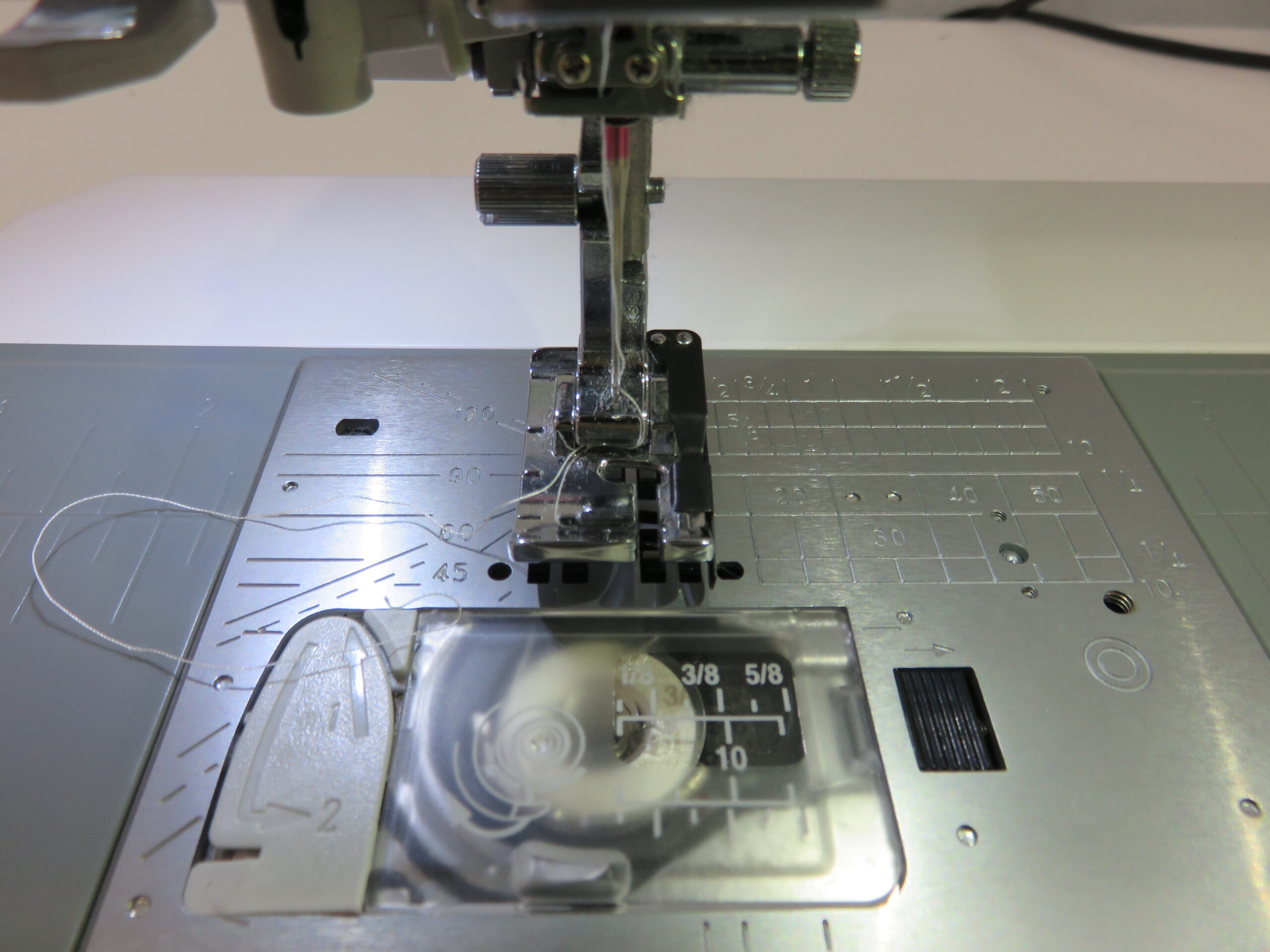 This foot is amazing at keeping seam allowances a consistent 1/4″ at all times, by utilizing a little black guide that slides up against the edge of the fabric being sewn.
This foot is amazing at keeping seam allowances a consistent 1/4″ at all times, by utilizing a little black guide that slides up against the edge of the fabric being sewn.
Thread the machine with the piecing thread you are using. Select needle setting D95S on the MC8900QCP SE for sewing with the quarter inch foot.
- Begin by grouping the jelly roll strips in groups of 5 strips. Most jelly rolls have 42 strips of fabric in them, so this should give you roughly 8 groups of 5 strips. You can randomly group them, or you can arrange them in whatever order you prefer.
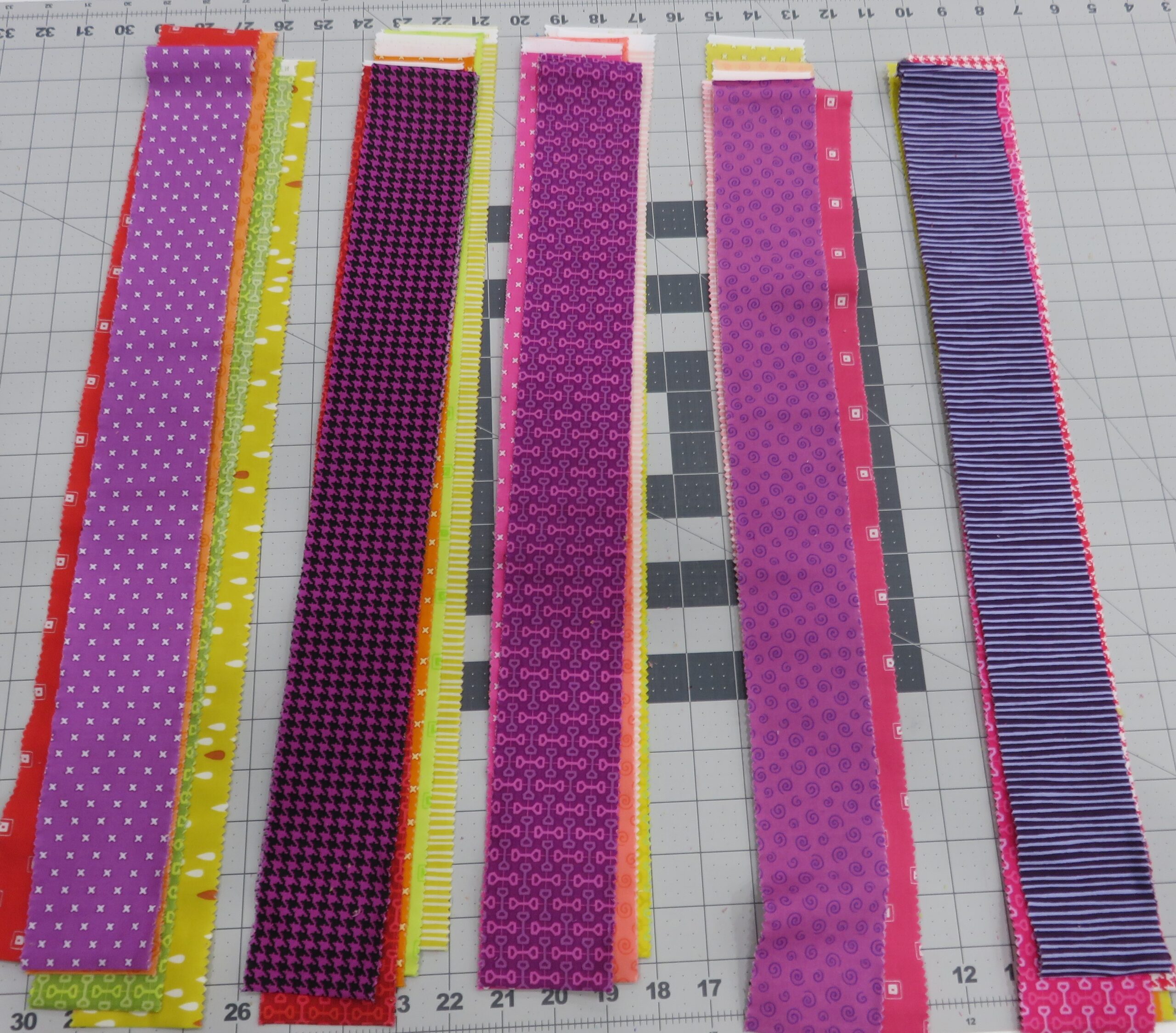
- You will sew each group of strips together, using the ¼” piecing foot. Feel free to chain piece here to save.

 Tip: Chain piecing is continually feeding the next blocks/strips into the machine without backstitching or cutting the thread. Once one block is completely through the feed dogs, let the machine sew for a stitch or two on air, then feed in the next piece. It saves a little time and a little thread!
Tip: Chain piecing is continually feeding the next blocks/strips into the machine without backstitching or cutting the thread. Once one block is completely through the feed dogs, let the machine sew for a stitch or two on air, then feed in the next piece. It saves a little time and a little thread!
- Once the 8 groups of 5 strips have been sewn together, take them to the ironing station and press the seams open. If desired, use spray starch.
- Place one of the sewn together strips on your cutting surface, with the strips oriented vertically. Take the 6.5” acrylic ruler on point, centered over the middle of the third strip. You can use a larger ruler at this point, but it will take a little more time to cut each block. The 6.5” ruler is a little more convenient and easier to position. Cut the 6.5” square out using your rotary cutter.

- Cut out as many 6.5” squares as you can from the pieced strips that you’ve created. Save the leftovers.
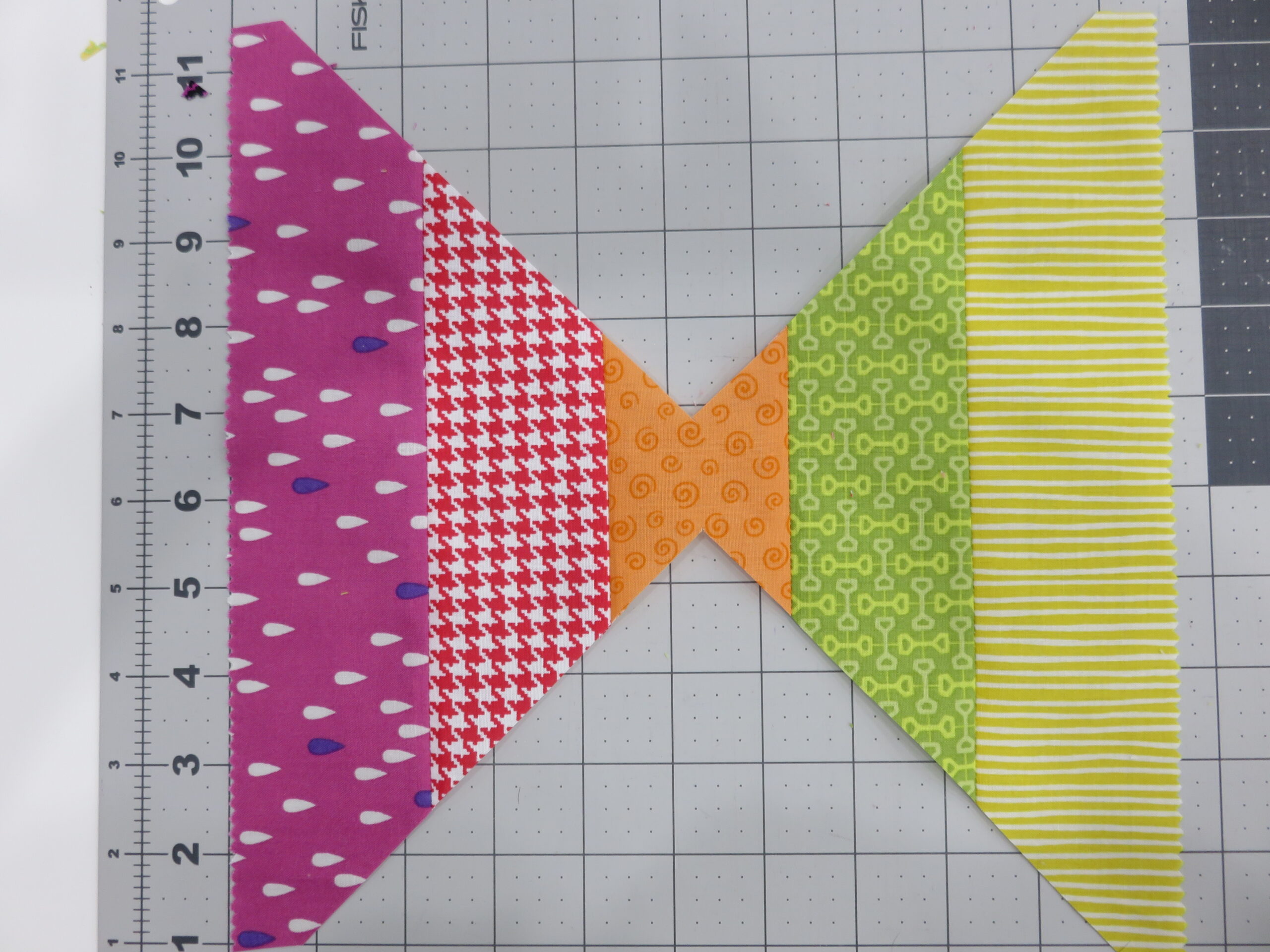
- Take the leftover pieces and if they are connected by a thin piece of fabric in the center, go ahead and cut that thin piece of fabric.

- Take the two triangles/leftover pieces that you have now, and place the long edges right sides together.
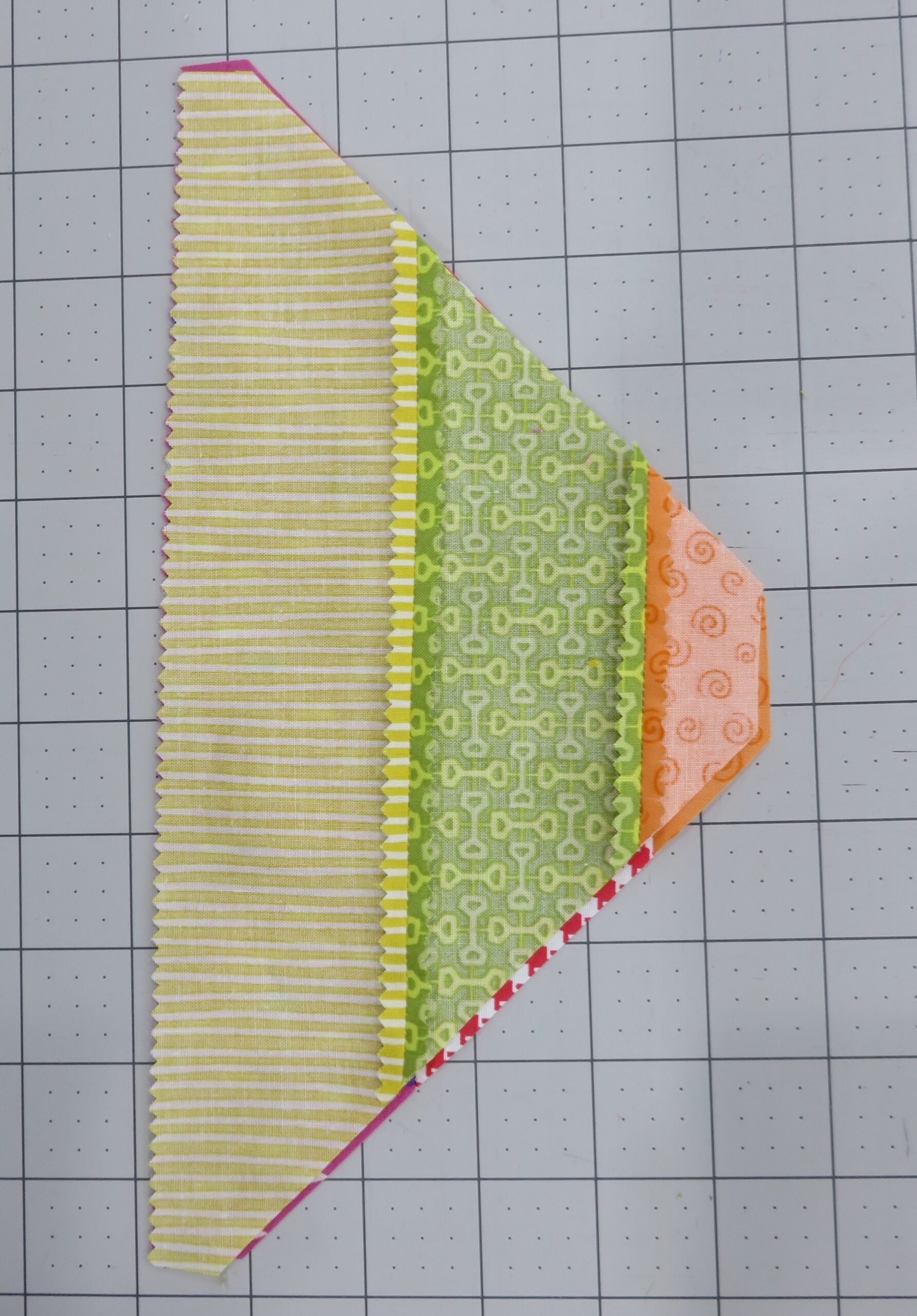
The purpose of this is to make the most of all the fabric from the jelly roll without wasting the scraps. Pin them in place, take to the sewing machine, and piece using the ¼” foot. Repeat this step with the remaining fabric scraps. Again, feel free to chain piece at this step.

- Take the remnant pieces you just sewed together to the pressing station and press the center seam open.
 Pressing the seams open will make the ruler sit flush on the fabric and eliminate much of the wobbling that might occur while cutting. It can also help to eliminate bulk when piecing the remainder of the top and while quilting. If you prefer to press your seams a different way, pressing the seams open is not critical to construction of this quilt.
Pressing the seams open will make the ruler sit flush on the fabric and eliminate much of the wobbling that might occur while cutting. It can also help to eliminate bulk when piecing the remainder of the top and while quilting. If you prefer to press your seams a different way, pressing the seams open is not critical to construction of this quilt.
- Take these pieces to the cutting station and you’ll use the 6.5” ruler again, positioned on point and lined up on the center prior to cutting. Continue cutting blocks out until you have a total of 48 blocks.

- Place the blocks on a design wall and position them in the way that you like. I chose to position them in an on point square type arrangement, but you can position them all going in the same direction, or in any type of layout pleasing to you. Arrange the blocks with six blocks in each row, with a total of 8 rows.

- Take the first block in the first row and place a 2” x 6.5” piece of sashing RST with the right edge of the block. Continue piecing the small sashing strips onto each right edge of the blocks in the first row, except for the sixth block.
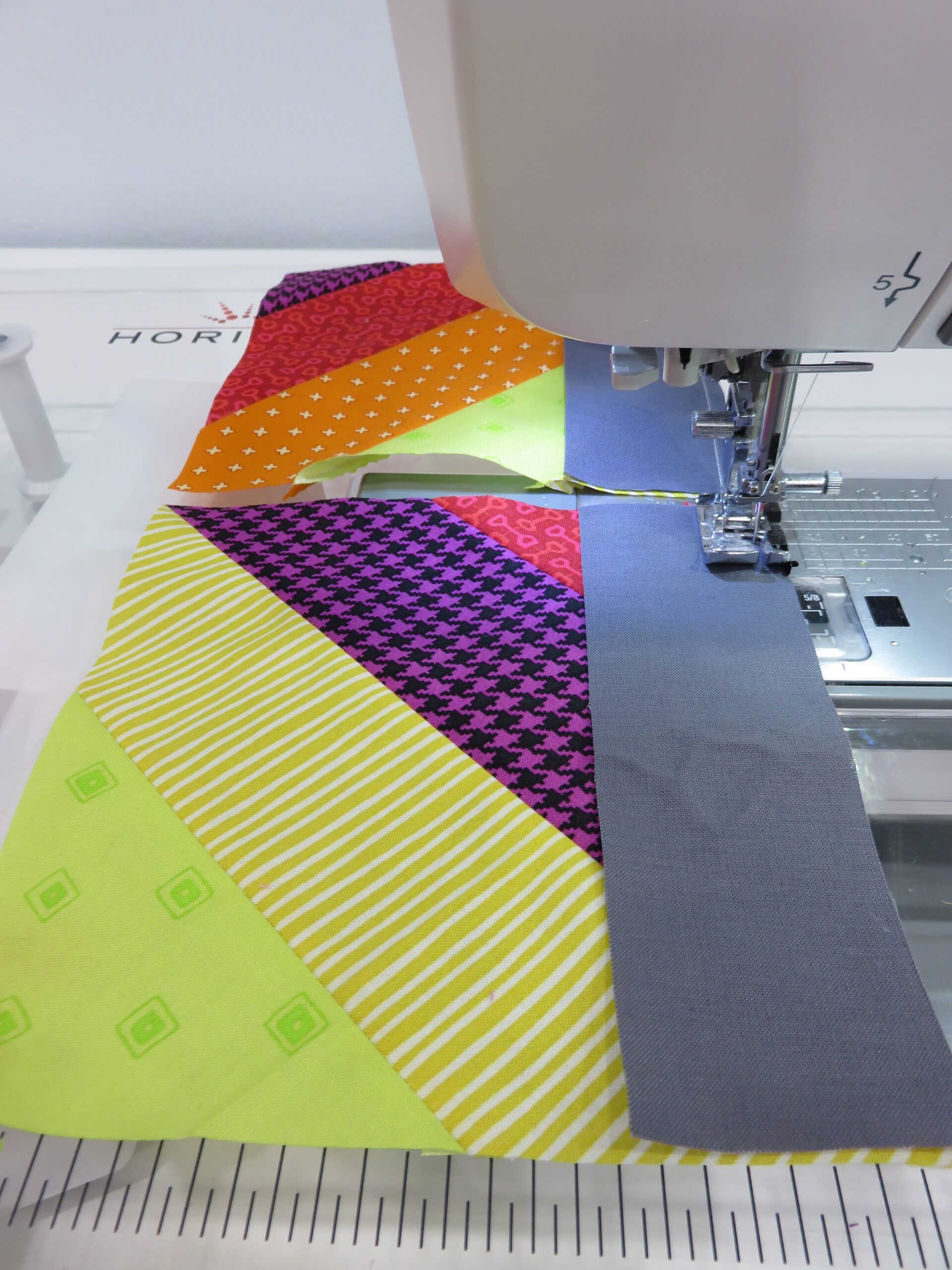
- Then take the first block in the first row (with the sashing piece sewn to it), and place the second block RST with the sashing piece of the first block. Piece each block in row one to the next until all 6 blocks are sewn together and have a 2” x 6.5” sashing piece in between each block (but not on the left edge of the first block or the right edge of the sixth block). Press seams.
- Repeat steps 12 and 13 for each row until all 8 rows are complete.
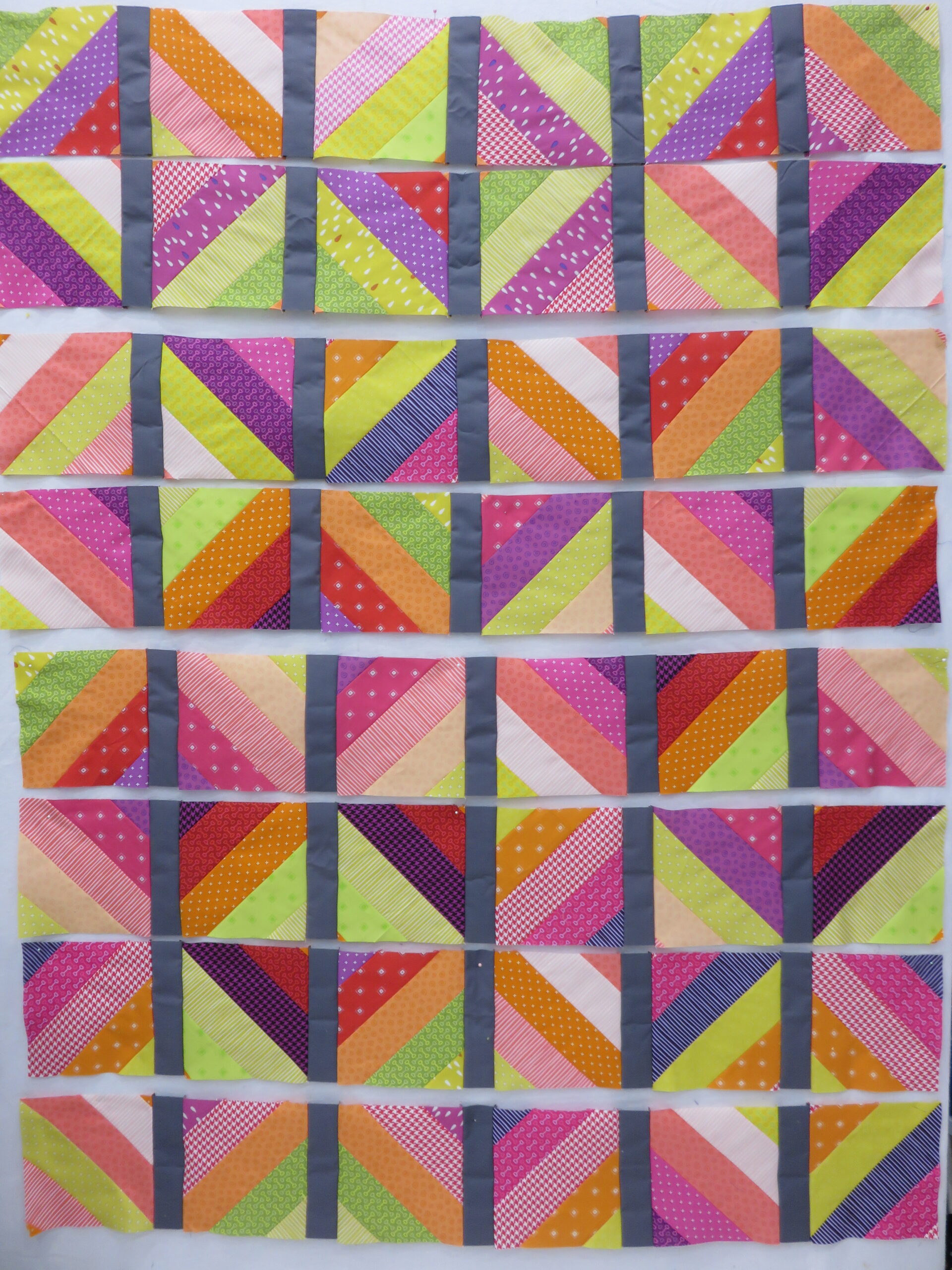
- Now we will sew the horizontal sashing to the rows and complete the horizontal borders. Take row 1, and one 4.5” x 44” border piece. Line the edge of the border piece up with the top edge of row 1, with right sides together. Pin in place. Sew together with a ¼” seam allowance. Press seam.

- Take one 2” x 44” horizontal sashing strip and line the edge of the border piece up with the bottom edge of row 1, with right sides together. Pin in place, and sew with a ¼” seam allowance.
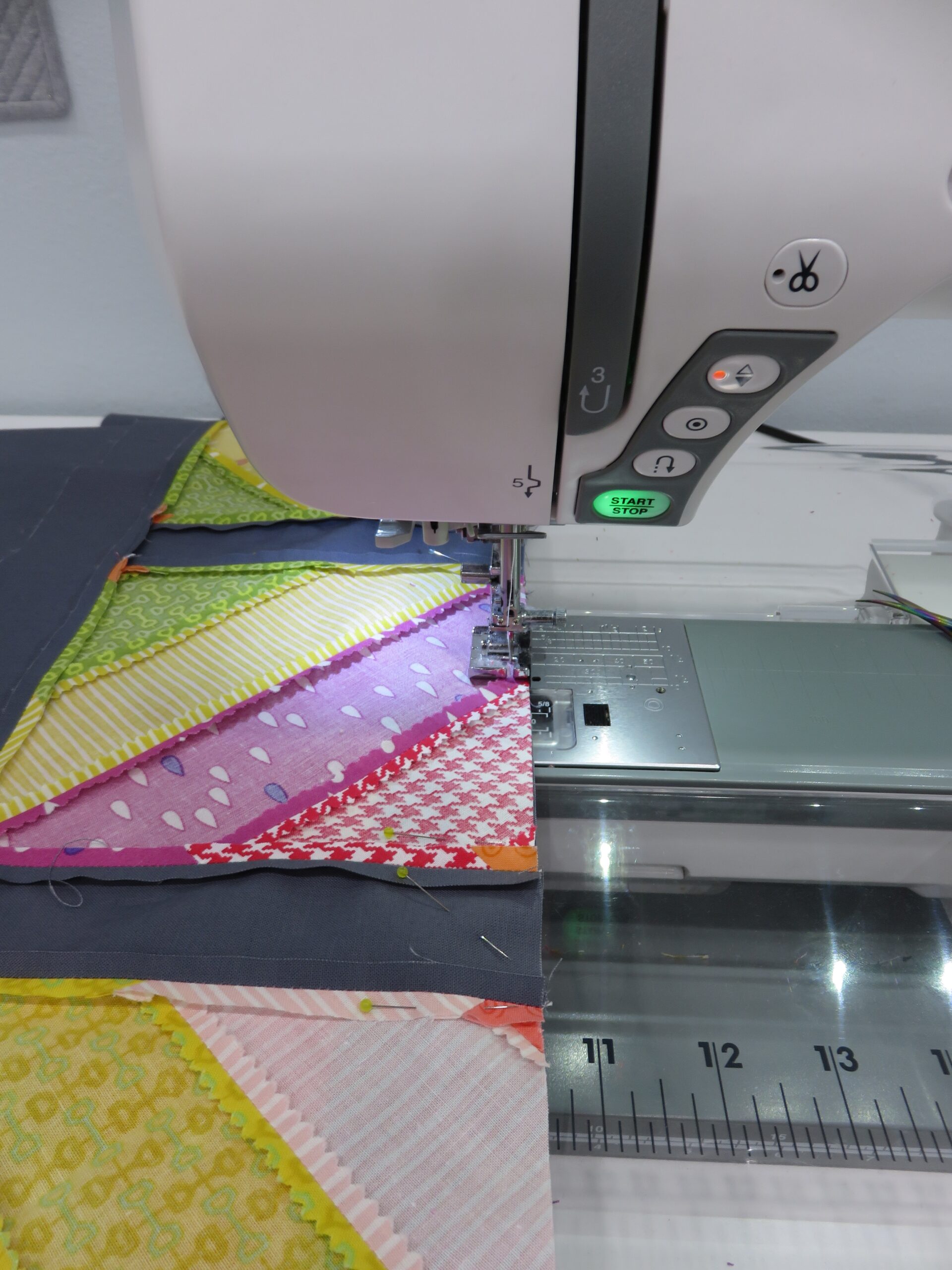
- Repeat step 16 with the bottom edge of rows 2-7, continuing to sew the 2” x 44” sashing strip to the rows.
- Take row 8, and the remaining 4.5” x 44” border piece. Line the edge of the border piece up with the bottom edge of row 8, with right sides together. Pin in place, and sew with a ¼” seam allowance. Press seams.
- Now all 8 rows are ready to be pieced together horizontally. Begin with rows 1 and 2, placed right sides together, and sew with a ¼” seam allowance. Repeat with each row (attach rows 2 and 3, 3 and 4, etc.). Pres seams.
- The quilt top is nearly completed, with only the right and left borders remaining. Place one 4.5” x 67” border right sides together with the left edge of the quilt top. Pin in place and sew with a ¼” seam allowance. Place the remaining 4.5” x 67” border right sides together with the right edge of the quilt top. Pin in place and sew with a ¼” seam allowance. Press seams. Starch the seams and the quilt top, if desired.

Quilting
- Prepare the backing. The backing should be no smaller than 60” x 75”. Take the two pieces of 60” quilting cotton, and piece the backing by pinning the 60” edges right sides together and sewing with a ½” seam allowance. Press the seam well and starch.
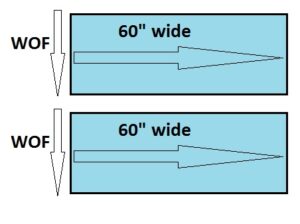
This will make your backing roughly 60” x 86-88”. If desired, you can trim some of the length off the backing at this step, or leave the excess until quilting is completed.
- Assemble a quilt sandwich with the backing, batting and top by placing the backing right side down. Place the batting on top of the wrong side of the backing fabric. Center the pressed quilt top right side up on top of the batting and backing. Keep in mind that the backing fabric and batting should be larger on all sides around the quilt top.
- Baste all the layers together in the manner you choose, being careful to keep all the layers flat and unwrinkled. This can be basted with your sewing machine, safety pins, or spray baste.
- Attach QBS foot for free motion. To attach this foot, you will need to remove the set screw and loosen the foot holder that held the quarter inch foot, and remove it. Then attach the convertible free motion foot to the presser bar and install the screw that will hold it in place. Lower the feed dogs. Adjust the presser foot pressure to “5” and set the machine to “D4S”.

- Wind bobbin with that quilting thread you’ve selected to quilt your jelly roll top. Thread machine with matching quilting thread.
- Quilt the layers together with any motif you desire. The quilt in the images was quilted with some fun loops and pebbles and straight lines.
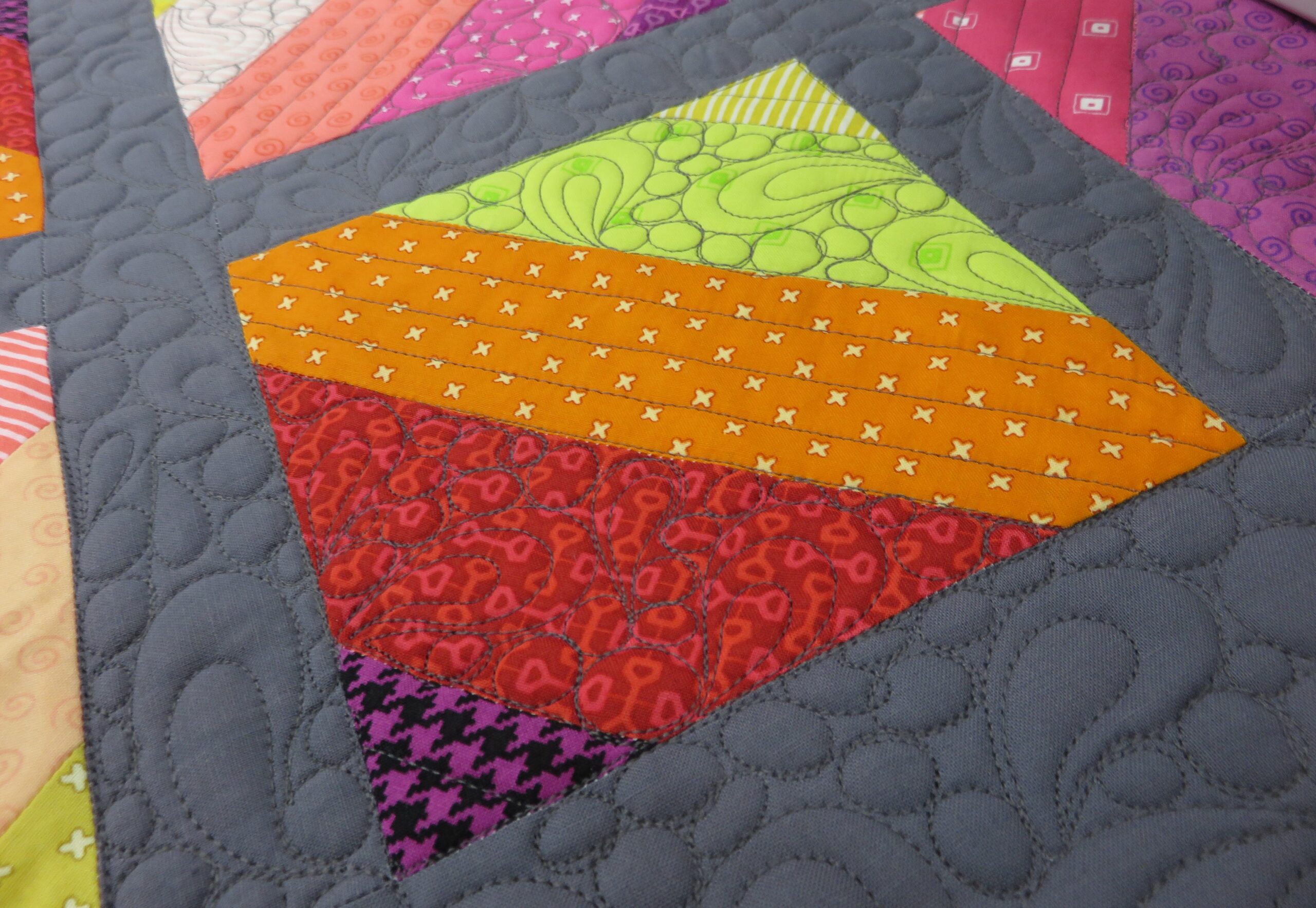
Tip: When free motion quilting, try to keep your quilting stitches a uniform length—not too small, and not too large. You may want to practice the quilting motif before starting on the quilt. Be sure to check the manufacturer’s suggestion for quilting distance on the batting you use.
- Once the quilting is completed, trim the sides of the quilt to square up prior to adding binding.
Binding
- With the binding fabric, cut (6) 2 ½” strips across the grain or cut bias strips, and join the strips to create at least 250” in total length.
- When the length is complete, press the strips in half lengthwise, wrong sides together.
- Attach the binding around the perimeter of the quilt, mitering the corners, and finishing with your favorite binding method.
Enjoy this new technique to start utilizing those great Jelly Rolls you have in your stash! Don’t be afraid to play with placement, cutting position, and block size to give more variety to this easy go-to pattern. Be sure to keep utilizing the awesome Janome quarter inch foot for all of your perfect piecing needs!
Save